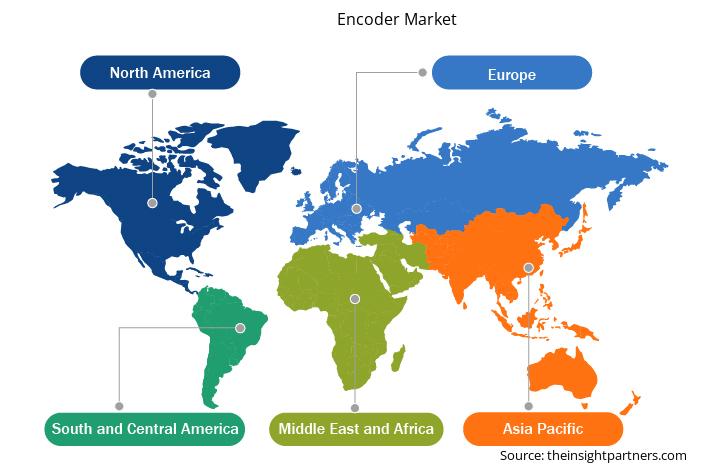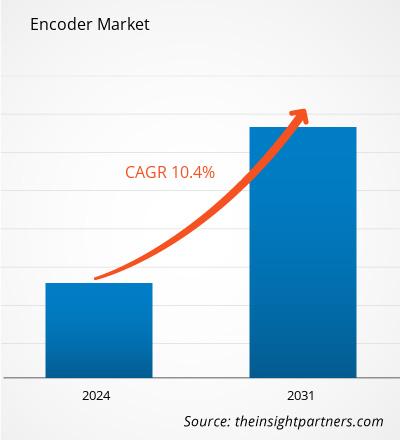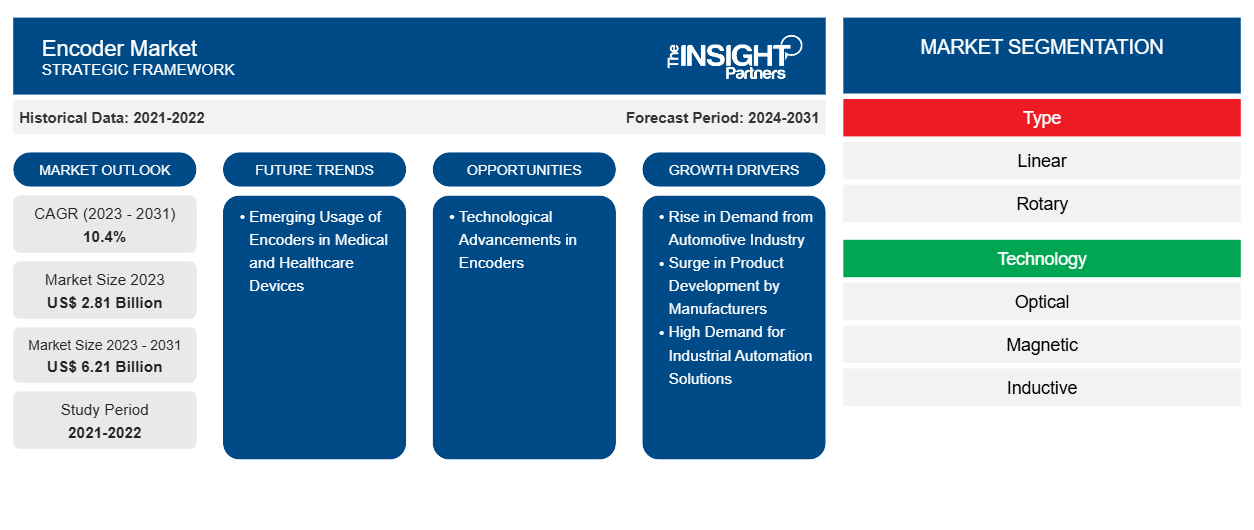Se prevé que el tamaño del mercado de codificadores alcance los 6.210 millones de dólares en 2031, frente a los 2.810 millones de dólares en 2023. Se espera que el mercado registre una CAGR del 10,4 % durante el período 2023-2031. Es probable que el uso emergente de codificadores en dispositivos médicos y sanitarios traiga nuevas tendencias al mercado en los próximos años.
Análisis del mercado de codificadores
El aumento de la demanda de la industria automotriz; la alta demanda de soluciones de automatización industrial entre las pequeñas, medianas y grandes empresas; y el enfoque de los fabricantes en la fabricación de automóviles nuevos son algunos de los factores importantes que impulsan el mercado de codificadores . Además, el aumento de la inversión en robótica y soluciones de automatización industrial aumenta la demanda global de codificadores. Además, se espera que el avance tecnológico y la integración de tecnologías avanzadas como la tecnología de Internet industrial de las cosas (IIoT), los codificadores de alta velocidad, los fotosensores de matriz en fase HD y un chip LED azul en codificadores que reducen los costos operativos creen oportunidades para el crecimiento del mercado durante el período de pronóstico. Además, el aumento de la demanda de codificadores personalizados, el enfoque de los fabricantes en el desarrollo de minicodificadores y un aumento en las actividades de investigación y desarrollo están impulsando el mercado de codificadores.
Descripción general del mercado de codificadores
Un codificador es un dispositivo que transforma el movimiento en una señal eléctrica que puede ser leída por un dispositivo de control de movimiento, como un contador o un PLC. Traduce información de un formato o código a otro, generalmente cambiando el movimiento físico o la posición en una señal digital. El codificador envía una señal de retroalimentación que se puede utilizar para calcular la posición, la velocidad y la dirección. Este procedimiento es necesario para mantener la uniformidad, la velocidad y la compresión en una variedad de aplicaciones técnicas. Los codificadores desempeñan un papel fundamental en la traducción de los movimientos mecánicos en datos eléctricos utilizables, lo que es necesario para el control y la automatización precisos del sistema. Los codificadores son componentes críticos de la tecnología moderna que garantizan la precisión y el control en una amplia gama de aplicaciones, incluidas la maquinaria industrial y la electrónica de consumo. Este nivel de precisión es esencial para tareas que requieren alta precisión, como líneas de montaje y robots quirúrgicos. Los codificadores se utilizan en dispositivos electrónicos de consumo, como ratones y teclados, para traducir las acciones del usuario en señales digitales que las computadoras pueden manejar, mejorando así la experiencia y la participación del usuario.
Personalice este informe según sus necesidades
Obtendrá personalización en cualquier informe, sin cargo, incluidas partes de este informe o análisis a nivel de país, paquete de datos de Excel, así como también grandes ofertas y descuentos para empresas emergentes y universidades.
-
Obtenga las principales tendencias clave del mercado de este informe.Esta muestra GRATUITA incluirá análisis de datos, desde tendencias del mercado hasta estimaciones y pronósticos.
Factores impulsores y oportunidades del mercado de codificadores
Aumento de la demanda en la industria automotriz
Los automóviles están cada vez más equipados con una gama de tecnologías avanzadas y digitales para hacer que la conducción sea más segura y cómoda para los usuarios. Los codificadores desempeñan un papel importante en la industria automotriz, mejorando la precisión, el rendimiento y la seguridad de muchos sistemas del vehículo. En los automóviles modernos y eléctricos, los codificadores se emplean en una variedad de aplicaciones, incluidos los sistemas de dirección asistida eléctrica (EPS), los sistemas de control del motor, los sistemas de frenos antibloqueo (ABS), los sistemas de control de tracción, el control de la posición de los faros y los sistemas de batería, entre otros. En los sistemas EPS, los codificadores se utilizan para monitorear la posición del volante asegurando un control y una respuesta exactos. De manera similar, en los sistemas ABS y de control de tracción, los codificadores se emplean para detectar y prevenir el deslizamiento de las ruedas, lo que ayuda a mejorar la estabilidad del vehículo. Por ejemplo, según el informe anual Global Electric Vehicle Outlook 2024 de la Agencia Internacional de la Energía (AIE), en 2023 se vendieron casi 14 millones de automóviles eléctricos en todo el mundo, lo que supone 3,5 millones más que en 2022, un aumento interanual del 35 %; Esto eleva el número total de coches en las carreteras a 40 millones. Este crecimiento en el número de coches muestra que la cuota de los coches eléctricos en el mercado global de coches ha aumentado al 18% en 2023, frente al 14% en 2022. Las crecientes ventas de coches eléctricos en todo el mundo impulsan la adopción de codificadores entre los fabricantes de automóviles para el control del motor en vehículos eléctricos e híbridos. Estos codificadores proporcionan información exacta sobre la velocidad, la posición y la dirección del motor, lo que permite una mejor eficiencia energética y un mejor rendimiento. La fiabilidad y la precisión de la información proporcionada por los codificadores son fundamentales para que los usuarios y los fabricantes mejoren el manejo del vehículo, cumplan las normas de seguridad y mejoren la tecnología de conducción autónoma. Además, el avance de la industria automotriz y el creciente desarrollo de la automatización y la electrificación aumentan la demanda de codificadores de alta precisión. Los codificadores de alta precisión se emplean en sistemas de conducción autónoma como el control de crucero adaptativo, que utiliza la velocidad y la posición de las ruedas para gestionar la aceleración y el frenado. Por tanto, la creciente demanda de circuitos integrados de codificadores de la industria automotriz impulsa el mercado de los codificadores.
Avances tecnológicos en codificadores
La creciente demanda de automatización industrial, eficiencia energética y soluciones sostenibles entre las industrias está impulsando la necesidad de codificadores tecnológicamente avanzados en todo el mundo. La integración de tecnologías avanzadas como la Internet industrial de las cosas (IIoT) y productos avanzados, incluidos codificadores de alta velocidad, fotosensores de matriz en fase de alta definición y un chip LED azul, con codificadores puede proporcionar funciones avanzadas de control y monitoreo, que podrían permitir aún más la recopilación y el análisis de datos en tiempo real. Por ejemplo, MELEXIS lanzó MLX90382, un CI de codificador de alta velocidad para automatización industrial, robótica y soluciones de movilidad. MLX90382 es un CI de codificador magnético absoluto integrado con un sensor de posición magnético monolítico. Combina un extremo frontal magnético de pasillo, un convertidor analógico a digital, procesamiento de señal digital en chip con latencia cero y múltiples controladores de salida, lo que hace que el dispositivo sea adecuado para aplicaciones impulsadas por motores eléctricos, como brazos robóticos, máquinas de tejer industriales y máquinas de embalaje automatizadas. El tamaño miniatura del MLX90382, su inmunidad a campos dispersos y su compatibilidad con detección tanto en el eje como fuera del eje permiten una integración sencilla en micromotores. Estos codificadores están diseñados para satisfacer la necesidad de la industria de una retroalimentación de alta velocidad que es esencial para corregir el funcionamiento y la seguridad de las aplicaciones impulsadas por motores eléctricos.
Según los datos de Valin Corporation de diciembre de 2022, el IIoT ofrece importantes ventajas a los codificadores al mejorar la accesibilidad, el rendimiento y la fiabilidad de los datos. El IIoT ofrece monitorización en tiempo real y diagnóstico remoto, lo que permite a los trabajadores realizar un seguimiento continuo de las condiciones y el rendimiento del codificador eliminando el tiempo de inactividad. Por ejemplo, el codificador Ethernet industrial Sendix de Kubler con una interfaz OPC UA integrada es muy adecuado para aplicaciones IIoT. Es capaz de automatizar la comunicación independiente del control con una solución en la nube u otro sistema de nivel superior. La configuración del codificador a través de Internet permite la comunicación entre sistemas y elimina fallos de forma rápida y eficaz en caso de avería. Por ejemplo, los codificadores Ethernet industriales de Kubler integrados con las interfaces Profinet, EtherCAT o EtherNet/IP admiten la interfaz OPC UA, lo que aumenta la versatilidad y permite transmitir datos al control, al servidor web o a la nube de forma simultánea. La integración de codificadores con sistemas habilitados para IIoT permite recopilar, procesar y almacenar datos de estos dispositivos en plataformas basadas en la nube, lo que ofrece información importante sobre los patrones de los equipos y las eficiencias operativas.
Por lo tanto, se espera que los avances tecnológicos en codificadores creen oportunidades para el crecimiento del mercado de codificadores durante el período de pronóstico.
Análisis de segmentación del informe de mercado de codificadores
Los segmentos clave que contribuyeron a la derivación del análisis del mercado de codificadores son el tipo y la tecnología.
- Según el tipo, el mercado de codificadores se divide en lineales y rotativos. El segmento rotativo tuvo una mayor participación en el mercado en 2023.
- Según la tecnología, el mercado de codificadores se segmenta en ópticos, magnéticos, inductivos y otros. El segmento óptico tuvo la mayor participación del mercado en 2023.
Análisis de la cuota de mercado de codificadores por geografía
El alcance geográfico del informe del mercado de codificadores se divide principalmente en cinco regiones: América del Norte, Asia Pacífico, Europa, Medio Oriente y África, y América del Sur y Central.
En 2023, América del Norte tuvo una participación de mercado significativa. Estados Unidos, Canadá y México se encuentran entre las principales economías de América del Norte. La región aporta una participación notable al mercado mundial de codificadores debido a las crecientes inversiones de las industrias en la adopción de robots. Por ejemplo, según los datos de la Federación Internacional de Robótica (IFR) publicados en abril de 2024, las industrias de Estados Unidos, Canadá y México están invirtiendo fuertemente en la adopción e instalación de robots para automatizar los procesos industriales. La automoción, la electricidad, la electrónica y la fabricación son las principales industrias que invierten significativamente en tecnologías robóticas, lo que aumenta la demanda de codificadores para navegar por la posición, la velocidad y el movimiento de las piezas robóticas.
Estados Unidos es el segundo mayor productor mundial de automóviles y vehículos ligeros después de China. Las ventas del mercado automovilístico en Estados Unidos aumentaron un 1%, con un récord de 14.678 robots instalados en 2023, que aumentaron un 47% con 14.472 unidades instaladas en 2022. En 2023, los fabricantes de automóviles y componentes representan el 33% de todas las implementaciones de robots industriales en el país. De manera similar, en 2023, las instalaciones de robots en Canadá aumentaron un 43% hasta las 4.616 unidades. La industria automotriz representó el 55% de las instalaciones de robots del país, y las ventas del sector automotriz aumentaron un 99%, con 2,549 unidades instaladas en 2023. Además, el número de robots instalados en la industria manufacturera de México alcanzó las 5,868 unidades en la industria automotriz en 2023. La industria automotriz es la que más adopta robots en el país, representando el 69% del total de instalaciones en las que las ventas totalizaron 4,068 unidades en 2023. La creciente expansión de la industria automotriz y la creciente instalación de robots impulsaron la adopción de codificadores en las líneas de producción automotriz. Los codificadores se utilizan en las líneas de fabricación automotriz para mantener una precisión constante, disminuir los errores y garantizar acciones repetitivas para los robots. Los robots en la industria automotriz son responsables de tareas como la instalación de piezas, la aplicación de recubrimientos y las complejas operaciones de soldadura. Los codificadores permiten a los robots reaccionar en tiempo real a cualquier diferencia posicional optimizando la eficiencia y la calidad de los procesos.
Perspectivas regionales del mercado de codificadores
Los analistas de Insight Partners explicaron en detalle las tendencias y los factores regionales que influyen en el mercado de codificadores durante el período de pronóstico. Esta sección también analiza los segmentos y la geografía del mercado de codificadores en América del Norte, Europa, Asia Pacífico, Oriente Medio y África, y América del Sur y Central.

- Obtenga los datos regionales específicos para el mercado de codificadores
Alcance del informe de mercado de codificadores
| Atributo del informe | Detalles |
|---|---|
| Tamaño del mercado en 2023 | US$ 2.81 mil millones |
| Tamaño del mercado en 2031 | 6.210 millones de dólares estadounidenses |
| CAGR global (2023 - 2031) | 10,4% |
| Datos históricos | 2021-2022 |
| Período de pronóstico | 2024-2031 |
| Segmentos cubiertos |
Por tipo
|
| Regiones y países cubiertos |
América del norte
|
| Líderes del mercado y perfiles de empresas clave |
|
Densidad de actores del mercado de codificadores: comprensión de su impacto en la dinámica empresarial
El mercado de codificadores está creciendo rápidamente, impulsado por la creciente demanda de los usuarios finales debido a factores como la evolución de las preferencias de los consumidores, los avances tecnológicos y una mayor conciencia de los beneficios del producto. A medida que aumenta la demanda, las empresas amplían sus ofertas, innovan para satisfacer las necesidades de los consumidores y aprovechan las tendencias emergentes, lo que impulsa aún más el crecimiento del mercado.
La densidad de actores del mercado se refiere a la distribución de las empresas o firmas que operan dentro de un mercado o industria en particular. Indica cuántos competidores (actores del mercado) están presentes en un espacio de mercado determinado en relación con su tamaño o valor total de mercado.
Las principales empresas que operan en el mercado de codificadores son:
- Corporación de microdispositivos Asahi Kasei
- Vishay Intertechnology Inc
- Enfermo AG
- Honeywell Internacional Inc.
- Compañía Rohm Ltd.
- Allegro MicroSystems Inc
Descargo de responsabilidad : Las empresas enumeradas anteriormente no están clasificadas en ningún orden particular.

- Obtenga una descripción general de los principales actores clave del mercado de codificadores
Noticias y desarrollos recientes del mercado de codificadores
El mercado de codificadores se evalúa mediante la recopilación de datos cualitativos y cuantitativos a partir de investigaciones primarias y secundarias, que incluyen publicaciones corporativas importantes, datos de asociaciones y bases de datos. A continuación, se enumeran algunos de los avances en el mercado de codificadores:
- OMRON Automation, un destacado proveedor de soluciones avanzadas de automatización industrial en la India, tiene como objetivo reforzar su estrategia comercial centrada en i-Belt, el servicio de soluciones de cocreación basado en datos de la empresa. OMRON, conocida por su amplia cartera que abarca sensores inteligentes, robots, visión, seguridad de máquinas, PLC, servomotores y variadores, se dispone a enriquecer aún más su línea de soluciones integrales mediante la integración con el servicio basado en datos i-Belt. (Fuente: OMRON, comunicado de prensa, agosto de 2023)
- Microchip Technology Inc. anunció una iniciativa plurianual de más de 300 millones de dólares para expandir su presencia en la India. A través de esta inversión, la empresa pretende establecer centros de investigación de semiconductores, diseño de chips e ingeniería de equipos en el país. Ese mismo mes, Microchip Technology Inc. inauguró un centro de investigación y desarrollo en Hyderabad. Según la empresa, es probable que el mercado de semiconductores en la India alcance los 64.000 millones de dólares en 2026, frente a los 22.700 millones de dólares de 2019. (Fuente: Microchip Technology Inc., comunicado de prensa, julio de 2024)
Informe sobre el mercado de codificadores: cobertura y resultados
El informe "Tamaño y pronóstico del mercado de codificadores (2021-2031)" proporciona un análisis detallado del mercado que cubre las siguientes áreas:
- Tamaño del mercado de codificadores y pronóstico a nivel global, regional y nacional para todos los segmentos clave del mercado cubiertos bajo el alcance
- Tendencias del mercado de codificadores, así como dinámicas del mercado, como impulsores, restricciones y oportunidades clave
- Análisis PEST y FODA detallados
- Análisis del mercado de codificadores que abarca las tendencias clave del mercado, el marco global y regional, los principales actores, las regulaciones y los desarrollos recientes del mercado
- Panorama de la industria y análisis de la competencia que abarca la concentración del mercado, análisis de mapas de calor, actores destacados y desarrollos recientes para el mercado de codificadores
- Perfiles detallados de empresas
- Análisis histórico (2 años), año base, pronóstico (7 años) con CAGR
- Análisis PEST y FODA
- Tamaño del mercado, valor/volumen: global, regional y nacional
- Industria y panorama competitivo
- Conjunto de datos de Excel
Informes recientes
Testimonios
Razón para comprar
- Toma de decisiones informada
- Comprensión de la dinámica del mercado
- Análisis competitivo
- Información sobre clientes
- Pronósticos del mercado
- Mitigación de riesgos
- Planificación estratégica
- Justificación de la inversión
- Identificación de mercados emergentes
- Mejora de las estrategias de marketing
- Impulso de la eficiencia operativa
- Alineación con las tendencias regulatorias























 Obtenga una muestra gratuita para - Mercado de codificadores
Obtenga una muestra gratuita para - Mercado de codificadores